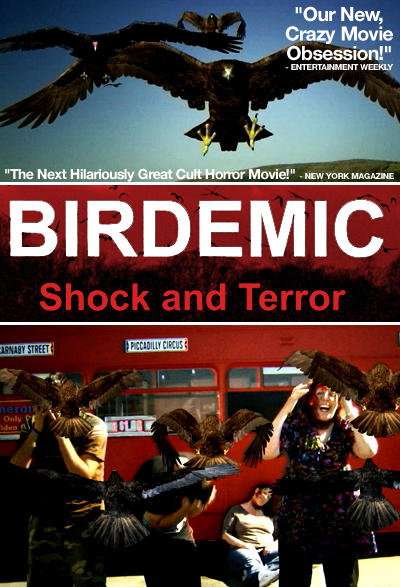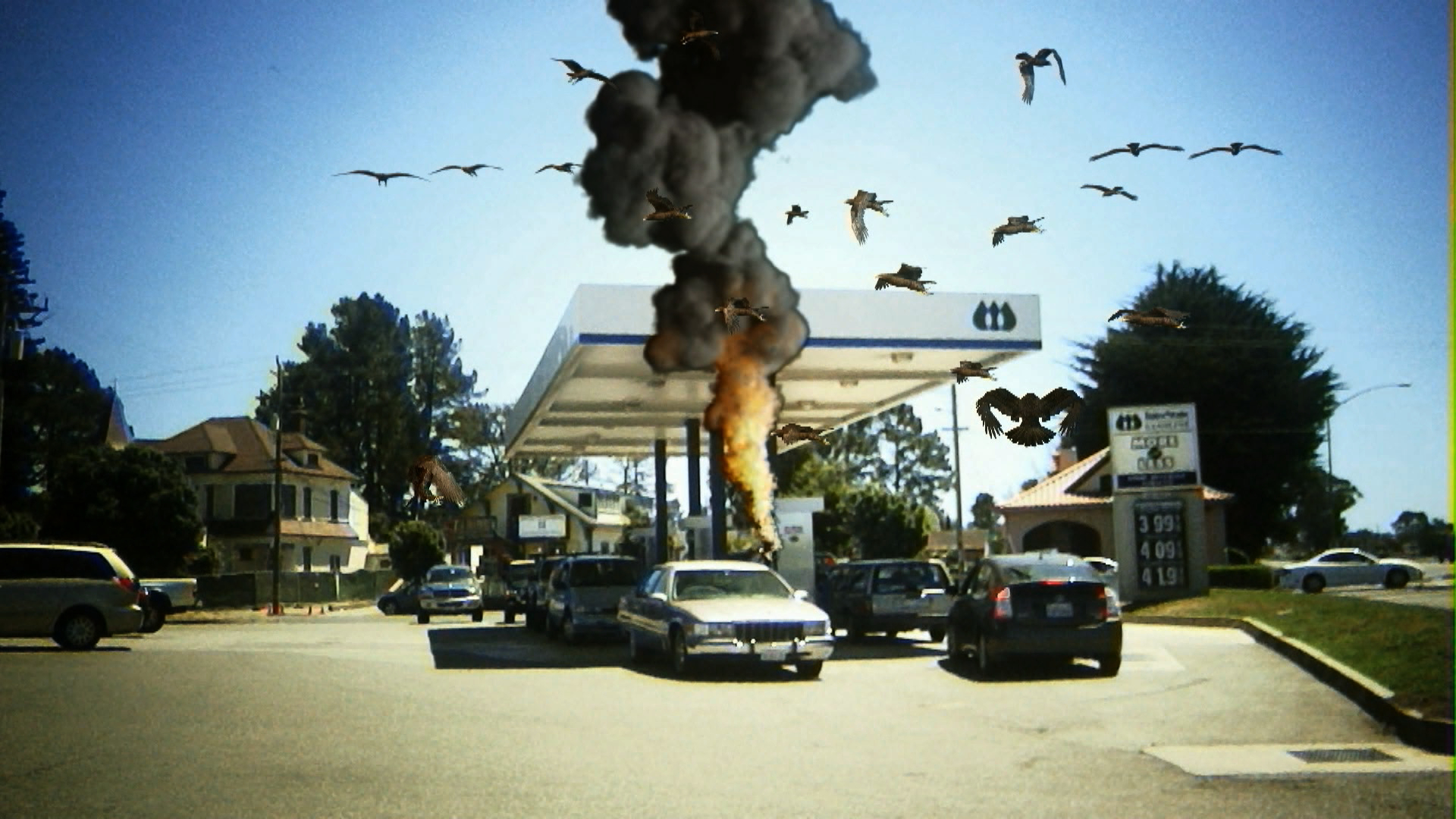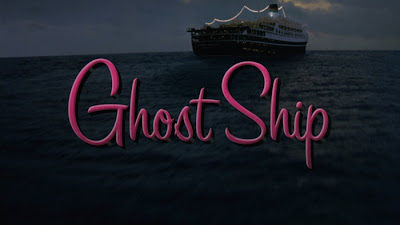 |
From https://thereservoirblogs.files.
wordpress.com/2011/05/birdemic_web.jpg |
Director: James Nguyen
Screenplay: James Nguyen
Cast: Alan Bagh (as Rod); Whitney
Moore (as Nathalie); Adam Sessa (as Ramsey); Catherine Batcha (as Becky); Janae
Caster (as Susan); Colton Osborne (as Tony)
A Night of a Thousand Horror (Movies) #23

After viewing
Birdemic, I've proven to myself unequivocally
that I hate ironic film viewing. Admittedly it doesn't help I watch like this
or
Samurai Cop (1991) by myself,
films which only really work in group situations preferably with alcohol
involved, but the idea of celebrating bad technique in cinema to merely mock it
is problematic and regressive. I openly admit to liking technically bad films
myself - from the Canadian oddity
Things
(1989) to
Batman & Robin (1998) -
but I love them sincerely as much for their fuck-ups as for the few virtues
they have, their failures causing me to laugh but also look on with delight as
they go into strange, irrational directions either because of the technical
decisions or the scripts.
Birdemic
makes
Manos: The Hands of Fate (1966)
look technically proficient in comparison and just a painful experience to sit
through. A modern day bastardisation of
Alfred
Hitchcock's The Birds (1963), in
which a small US town is invaded by CGI eagles, it felt better to just lift
bullet points rather than try to make a cohesive set of paragraphs.
+ The experience was so tedious I immediately
rewatched The Birds afterwards. It's
completely unfair to compare the two but it's impossible not to when it comes
to how long each takes to establish the characters and their drama until, forty
plus minutes later or so, the killer birds are on them. Kicking Birdemic when its down is unfair but it's
amazing how colourless and lacking the personality the dialogue is. The first
forty minutes is meant to be a romantic film but most of the dialogue is about
environmental concerns or the most rudimentary of content, short characterless
verbs which don't lead to any colourful dialogue from the characters as it
should in real life or a film with a fun script. None of the oddness sincerity
of something like Plan 9 From Outer
Space (1959) is there either to help avoid this robotic tone from these
empty platitudes and statements making it worse.
+ As someone who has watched a lot of low budget
films, and can get wisdom from those who've watched even more of them such as
the No-Budget Nightmare podcast, one
of the biggest issues with very low budget films is how they build up an entire
feature length beyond the main set pieces to link them together. Dialogue and
establishing scenes can be the death of high budget Hollywood films let alone
the likes of this, one of the biggest dangers especially in horror or thriller
cinema like this when characters merely stand around discussing exposition without
rhythm or dynamics to the glue of these scenes to connect set pieces. Birdemic
for a great deal of its length before and after the CGI eagles start to attack
filled with non-entity dialogue either meaningful or funny to gain from them. A
large part of it is that no one really wants to hear characters talk about
their plans to set up a company to develop solar panel technology or be involved
in software company meetings, but if you have to do so, it helps (which James Nguyen) doesn't if you actually
have some depth to these conversations that sounds like the characters actually
have knowledge on any of these subjects, not merely the most vague surface
words about the topics.
+ The sound is an irritance in this fact as, while
clear and audible, you can heard the transition in background noise from each
shot being edited together to the point of irritance. In fact the constant
abrupt changes in noise bring out the fact the film uses way to many edits just
for single scenes.
+ Because of this, I have sympathy for the actors
especially the leads Alan Bagh and Whitney Moore, who seem like likable people
but are struggling without hope against dialogue that really doesn't allow them
to even show charisma onscreen, turgid to sit through as a main plot threat is
about environmental concerns and the lead hero wanting to create pioneering
solar panel technology. Considering they are supposed to have a romance, even
terrible purple prose romantic dialogue would've been a benefit and more
rewarding, the more soppier and melodramatic the better.
+ A huge problem, which has been frequently talked
of already, is the film's laborious, empty headed pro-environmental message
which has no actual depth to it, merely screaming at the top of its voice about
saving the environment but sounding like it's from someone who has no idea how
to or what the subject involves. It actually comes off as a best-worst example
of how not to do polemic messages in cinema. I'm the stereotypical left wing
liberal but I hate follow liberals with probably more vitreous at times than
even the extreme right, because of their lackadaisical, hypocritical and howled
viewpoints, simplistic and misguided points on subjects that need greater tact
to them to improve the world for the better. One of the biggest problems with
messages in cinema, barring the fact that I find most social message dramas a
waste of time and overrated, is that if the film is bland or terrible no
progressive message within it, even if its applaudable morally, is of worth as
its been compromised and squandered. This is more significant now as big
companies in Hollywood, whether they have any progressive views in mind or are
cynically doing so, are becoming more progressive on the surface in their
choices, such as the plan to cast an African American actress as Mary Jane
Watson in the next Spiderman film,
applaudable ideas but in danger of being empty gestures if they're compromised
by a bad film around them. Birdemic's
the kind of film that'd put people off environmental concerns if they took it
seriously at all, probably what some people think all those with environmental
concerns actually sound like.
+ When the CGI eagles do actually appear after
what feels like two hours already, the result isn't that spectacular still,
most of it consisting of actors waving their hands randomly in the air with
eagles superimposed afterwards. Even the inclusion of wire coat hangers as a
self defensive weapon only lasts for a brief moment, not enough time to stick
out, exceptionally disappointing when that was an "iconic" moment in
terms of the film's cult reputation.
+ There were some virtues. The music by Andrew Seger at the beginning was surprising
in how good it was considering the film's reputation. Unfortunately the film
drags so much the music starts to feel the effect and became bland as the plot
goes along, but at the beginning its surprising in quality.
+ There's one vaguely funny character, a tree
hugger living in the woods, who reminded me of a low rent Woody Harrelson. That Harrelson
has played a character like this in Roland
Emmerich's turkey 2012 (2009) added
humour to this fact.
+ The two children the leads rescue are comically
absurd in their behaviour. Most of Birdemic
as the CGI eagles attack consists of the characters going shopping and driving
on country roads. Despite the dead bodies and people trying to rob them at
gunpoint for petrol, there's no sense of trauma especially from the children
and the only clear danger is that gasoline now costs $100 dollars because of
this freak natural disaster. The children's complaint near the end, when they
have to catch fish and fresh seaweed to sustain themselves, that they want a
McDonald's instead is one of the most unintentionally spoilt and deluded things
ever utter from child characters, so much so that even a viewer with no malice
in them would want these fictitious characters to have their eyes poked out by
the CGI eagles regardless of their ages.
+ The viewing experience altogether reminded me,
while its be a long time since I've seen it, that there's a potentially more
rewarding rip-off of The Birds from
Mexico that should've had more attention. Beaks:
The Movie (1987), directed by Rene
Cardona Jr., the same man who made the Video Nasty Night of the Bloody Apes (1969), was far and away more entertaining
back when I saw it, having the same delirious tone of the genre films the
Italians were making in the eighties (being a co-production) and had, even if
through crude effects, real birds involved. The idea of a character being mauled
by a savage canary bird, one of many quite inventive scenes in the film, is a
hell of a lot more rewarding than the CGI eagles in Birdemic.
In any other circumstance I'd
have rated this merely a 2/10, never someone to condemn films any lower in
rating, but the context and background behind Birdemic's public popularity and its tone as a movie is so
disappointing to me that I have to call it a 1/10 film and one of the worst
I've seen in content and attitude. It's not the technical deficiencies that
stand out but its general mediocre attitude to being bad filmmaking, not even
rewarding for its failure, and not having any of the charm of older infamous
films. That there films made with less budget that are better than this, but
this one got the cult status, is another reason I hate this film, something
like Jennifer Help Us (2014) shot on
an iPhone and managing to be a little gem in spite of its few flaws more
deserving of this film's popularity. That it feels so pleased with itself in
its hollow environmental message and cribbing of Alfred Hitchcock's film is utterly obnoxious and detestable.
 |
From https://thewolfmancometh.files.wordpress.com/
2010/03/birdemic-gas-station.jpg |










